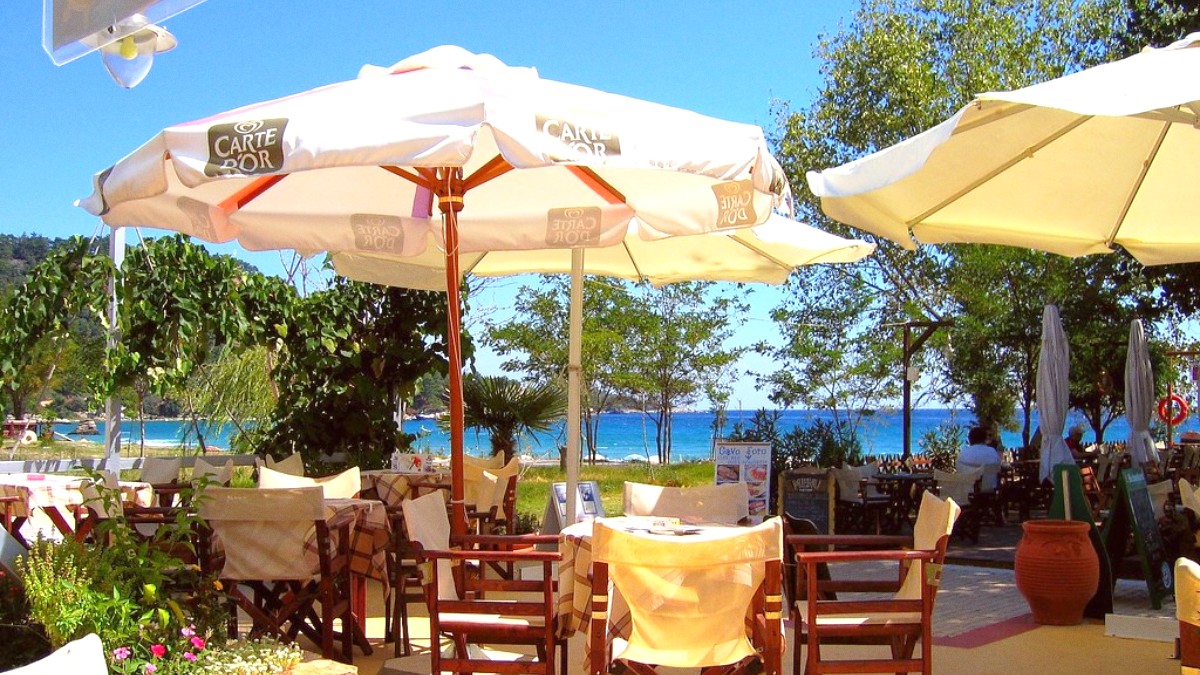
Northeastern Aegean Islands, Greece
Mount Ipsarion, the island's highest peak, stands proudly in the center, reaching heights that provide panoramic views of the entire island and the surrounding sea. Its slopes draw many hikers. The island’s coastline measures approximately 100 kilometers. It features a diverse range of beaches, from long stretches of golden sand, like Golden Beach, to secluded coves with white marble pebbles, like Saliara Beach. Rocky outcrops and dramatic cliffs also mark the shoreline, creating a varied and picturesque coastal environment.
Freshwater springs dot the island, feeding small streams that contribute to its green appearance, especially during spring. The island benefits from a ring road that encircles the coast, connecting the main towns and villages.
Limenas, also known as Thasos Town, is the capital and main port on the northern side. Limenaria and Potos are other significant towns on the southern coast, each with its own character and amenities. The island’s terrain presents a mix of flat coastal plains and rolling hills leading up to its mountainous interior, providing diverse environments for exploration.
Thasos possesses a long and layered history, with evidence of human presence dating back to the Paleolithic era. Its history is deeply tied to its natural resources, specifically its rich marble quarries and gold mines. The island rose to prominence in ancient times due to these valuable resources. Thasian marble held value throughout the ancient world, used in temples, statues, and important buildings across the Mediterranean. Its gold mines, first worked by the Phoenicians, brought immense wealth and influence to the island.
In the 7th century BC, Greek settlers from Paros established a colony on Thasos, leading to its development as a strong maritime and commercial power. The ancient city of Thasos, located where modern Limenas stands, became a thriving hub. It featured an agora, temples dedicated to various deities, an acropolis, and a theatre. The island's strategic position and wealth made it a coveted prize, leading to numerous conflicts. Thasos joined the Delian League, a confederacy of Greek city-states led by Athens, but later rebelled, facing Athenian sieges. The island’s history includes periods of Macedonian rule under Philip II, who recognized its gold reserves, and later Roman dominance. Under Roman rule, Thasos continued to prosper, with further development of its infrastructure and cultural life. Following the Roman era, Thasos became part of the Byzantine Empire.
Evidence of early human presence.
Greek colonization by Paros; rise as a maritime power.
Involvement with Delian League, Macedonian & Roman rule.
Rise of Christianity, construction of basilicas.
Ottoman rule, shift to olive oil production.
This period saw the rise of Christianity, with many early Christian basilicas built on the island, some of which exist today (e.g., in Aliki). The island faced pirate raids and various invasions throughout the Byzantine centuries. In the 15th century, Thasos fell under Ottoman rule, remaining part of the Ottoman Empire for nearly five centuries.
During the Ottoman period, the island’s economy shifted, with olive oil production becoming a main industry. Many of the traditional mountain villages, like Theologos, flourished during this period as residents sought refuge from coastal raids.
Thasos finally rejoined Greece in 1912 after the Balkan Wars, marking the end of its long foreign rule. Archaeological sites and museums across the island preserve these layers of history, offering visitors a tangible connection to the past.
The island's story is one of enduring prosperity, conflict, and cultural exchange, all shaped by its geography and resources.
Thasos provides a varied experience for different types of travelers. For those who love the sea, the island presents an abundance of beaches. Golden Beach, on the east coast, with its soft sand and calm, shallow waters, is a favorite for families. Paradise Beach, with its striking turquoise waters, features a more secluded feel, surrounded by lush vegetation. Saliara Beach, also known as Marble Beach, dazzles with its white marble pebbles and clear, almost iridescent blue water, a truly unique sight.
These beaches cater to both those seeking organized facilities with sunbeds and beach bars and those who prefer a more natural, uncrowded setting. The clear waters around the island are also ideal for swimming, snorkeling, and diving, revealing diverse marine life.
Traditional mountain villages like Panagia and Theologos offer a glimpse into authentic Greek island life.
Ancient Agora, Archaeological Museum in Limenas, and the Monastery of Archangel Michael wait to be explored.
Fresh seafood, high-quality olive oil, and aromatic pine honey are local culinary staples.
Thasos welcomes outdoor activities. Its extensive network of trails through pine forests and up mountain slopes makes hiking and mountain biking popular. The coastal ring road is a favorite for cyclists. Water sports are available at many organized beaches.